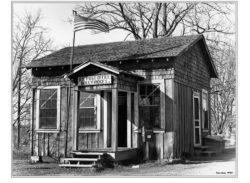Lee Estes
Photographer Lee Estes is best known for his precise and extensive black and white photographic documentation of vernacular subjects, especially architecture.

Courtesy of Lee Estes
Louisiana Holly Ridge. Estes, Lee (Photographer)
A resident of Monroe, Louisiana, for more than half a century, photographer Lee Estes is best known for his precise and extensive black-and-white documentation of vernacular subjects, especially architecture. A native of Winchester, Kentucky, where he was born in 1927, Estes was educated in local schools. His enrollment at Kentucky’s Centre College in 1942–43 was interrupted by the call to military service as a pilot, and he became interested in photography when stationed in Merseberg, Germany, following the end of World War II. Self-taught as a photographer, Estes was attracted to the technique and vision of some of the medium’s masters of black-and-white prints—Edward Steichen, Ansel Adams, and Margaret Bourke White. He considers their period of photography, the 1930s through the 1960s, the medium’s golden age. In 1956, Estes moved to Monroe, Louisiana, and since that time he has been photographing the northeastern areas of the state (and wherever else his travels take him) with an eye for detail and an appreciation of history and both the natural and man-made environments.
Estes worked with modest equipment during his years of military service: a simple box camera, scrounged film and supplies, homemade equipment, and other seat-of-the-pants techniques pressed into the service of photography. Upon his return to the United States, a better camera he acquired before leaving Germany allowed him to photograph professionally. He initially shot weddings, a niche he found unsatisfying.
Shortly after arriving in Louisiana, Estes established the North Louisiana Camera Club and participated in the Gulf States Camera Club Council, two groups that are still functioning. The competitions that these groups sponsored for their members allowed winners to compete at the national level. Estes joined the Photographic Society of America (PSA) in 1960, shortly thereafter capturing a gold medal in California, which launched him into the sphere of international competitions, or salons. He fared well in these competitions, which awarded points for prizewinning photographs. In 1986, the PSA ranked him fourth in the United States and fifteenth in the world. He has been a Fellow in that organization since 1990.
In the 1970s, through the North Louisiana Camera Club, Estes began organizing photographic tours to foreign destinations. He conducted tours to China, Portugal, Greece, New Zealand, Denmark, Morocco, and Yugoslavia. An unpublished manuscript, “The Coach Stops Here,” is a chronicle of these journeys. Estes has seen two book projects come to print. The first, Fading Textures (2000), included nearly 400 images of places in northeast Louisiana, many of them gone since he started photographing the region in 1957. His 2005 book, Fading Warriors, profiled in interviews and photographs forty-seven veterans of World War II.
As that third work indicates, Estes has changed with the times, as indicated in his latest project: documenting the Dixie Overland Highway (U.S. 80) though digital photography. Though darkroom processing was essential to him during his early decades as a photographer, he has embraced digital photography and making prints that consist of pigments rather than silver compounds.
In addition to his exhibitions at various PSA group competitions, Estes has had solo exhibitions of his photographs. Images de France (1999) at the Schepis Center in Columbia, Louisiana, presented 50 photographs of France to commemorate the tricentennial of the French presence in Louisiana. Another exhibition, Beyond the Postcard, was presented at the Schepis Center in 2006. Other exhibitions have been held at the Masur Museum of Art in Monroe, Louisiana; Louisiana Tech University in Ruston; Northeast Louisiana University in Monroe (now Louisiana State University at Monroe); and the Meridian Museum of Art in Mississippi. Estes has received a number of honors for his photographic work. In 1999, the Northeast Louisiana Arts Council named him Artist of the Year. In 2001, the Louisiana Endowment for the Humanities bestowed on him a Special Humanities Award for his contributions in documenting the culture of the state.
